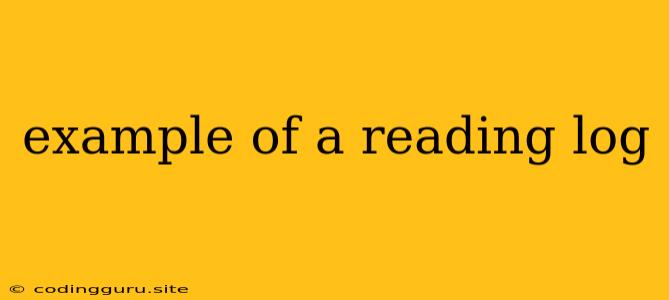What is a Reading Log?
A reading log is a valuable tool for anyone who wants to keep track of their reading habits and progress. It serves as a record of the books you've read, helping you remember details, analyze your preferences, and even motivate you to read more.
Why Keep a Reading Log?
There are numerous benefits to keeping a reading log. Here are just a few:
- Enhanced Memory: Recording details about the books you read helps you recall important events, characters, and themes.
- Track Your Reading Habits: You gain insight into your reading patterns, identifying genres you enjoy, authors you favor, and the amount of time you spend reading.
- Set Reading Goals: By tracking your progress, you can set realistic goals for the number of books you want to read each month or year.
- Encourage Reflection: A reading log prompts you to think critically about the books you've read, exploring their themes, characters, and impact on you.
- Share Your Reading Experiences: It's a great way to share your thoughts and recommendations with friends, family, or online communities.
Types of Reading Logs
There are many different ways to keep a reading log, from simple handwritten notes to sophisticated digital applications. Here are some popular examples:
- Notebook: A classic and versatile option, allowing you to personalize your log with handwritten notes and sketches.
- Spreadsheet: A structured approach for organizing data, ideal for tracking multiple books, authors, and genres.
- Digital Apps: Dedicated reading apps like Goodreads and StoryGraph offer features like book tracking, reviews, and community connections.
- Journal: A more personal approach, combining reading reflections with personal thoughts and feelings.
What to Include in a Reading Log
The content of your reading log is up to you, but here are some common elements to consider:
- Title: The book's title and author's name.
- Genre: The book's genre, such as fiction, non-fiction, mystery, or romance.
- Dates: The start and end dates of your reading.
- Rating: A star rating or a numerical score reflecting your enjoyment.
- Summary: A brief overview of the book's plot, characters, and themes.
- Thoughts: Your personal reflections on the book, including your favorite passages, characters, or themes.
- Quotes: Quotes from the book that resonate with you.
Example of a Reading Log
Here's an example of a simple reading log entry:
Book: The Lord of the Rings Author: J.R.R. Tolkien Genre: Fantasy Dates: August 10 - September 20 Rating: 5 Stars Summary: An epic tale of good versus evil, following the quest of Frodo Baggins to destroy the One Ring. Thoughts: This book truly transported me to Middle-earth. I was captivated by the complex characters, intricate world-building, and timeless themes.
Tips for Keeping a Reading Log
- Choose a Method That Suits You: Experiment with different formats until you find one you enjoy using.
- Be Consistent: Make a habit of updating your log regularly, even if it's just a few minutes after finishing a chapter.
- Don't Overthink It: Focus on capturing your genuine thoughts and impressions, rather than striving for perfect prose.
- Use It as a Tool for Discovery: Your reading log can help you identify new authors, genres, and themes to explore.
- Share Your Experiences: Connect with others who enjoy reading by sharing your entries online or in book clubs.
Conclusion
Keeping a reading log is a rewarding practice that enriches your reading experience. It helps you remember the books you've read, track your progress, and engage in deeper reflection. By finding a format that suits your style, you can unlock a wealth of insights and enjoyment from your reading journey.
